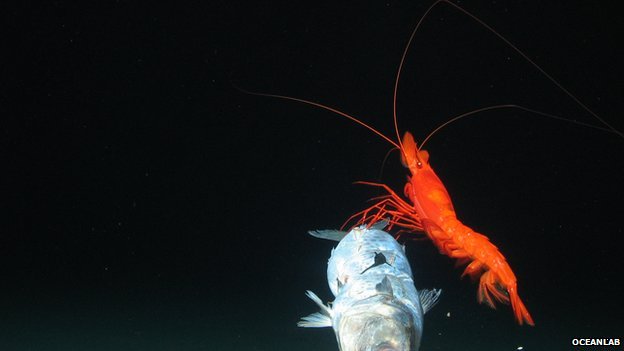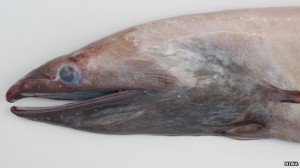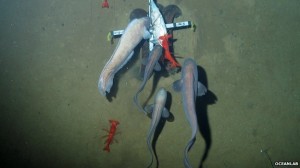News
Images Reveal a Previously Unexplored Deep Sea Trench

Scientists have had the first look at the life that thrives in one of the deepest spots in the ocean.
An expedition to the unexplored New Hebrides trench in the Pacific has revealed that cusk eels and crustaceans teem more than 7,000m (23,000ft) down.
The team used an unmanned lander fitted with cameras to film the deep-sea creatures.
The scientists said the ecology of this trench differed with other regions of the deep that had been studied.
“We’re starting to find out that what happens at one trench doesn’t necessarily represent what happens in all the trenches,” said Dr Alan Jamieson, from Oceanlab at the University of Aberdeen, UK, who carried out the expedition with the National Institute of Water and Atmospheric Research in New Zealand.
There are more than 30 deep-sea trenches around the world, and most of these narrow fissures in the seafloor lie in the Pacific Ocean.
Until this expedition, the depths of New Hebrides trench, which sits about 1,500km (1,000 miles) north of New Zealand, had not been explored.
The footage captured by the team during the 30-day voyage at the end of 2013 shows large, grey cusk eels, some 1m-long, chomping on the bait that had been attached to the lander.
The fish mingle with large, bright red prawns scrabbling around on the sandy seabed, which plunges down to 7,200m at its deepest point.
They also spotted eel pouts, arrow-tooth eels and thousands of smaller crustaceans, some of which were collected and brought back to the surface.
However, the team noted marked differences when they compared this trench with others they have studied, which include the Japan trench, the Izu-Bonin trench and the Kermadec among others.
Dr Jamieson said: “The surprising thing was that there was a complete and utter lack of one of the most common deep sea fish we would expect to see. Anywhere else around the Pacific Rim, around the trenches we’ve looked at, you see a lot of grenadiers – they are quite a conspicuous part of the deep-sea community. But when we went to the New Hebrides trench, we didn’t see a single one.
 “But what we did see was a fish called the cusk eel. These turn up elsewhere but in very, very low numbers. But around the New Hebrides trench, these – and the prawns – were all that we saw.”
“But what we did see was a fish called the cusk eel. These turn up elsewhere but in very, very low numbers. But around the New Hebrides trench, these – and the prawns – were all that we saw.”
There was also an absence of snail fish, a small pink fish usually seen in the deepest depths of ocean trenches.
The researchers believe the differences are driven by how nutrient-rich the region of ocean above the trenches is.
“If you look at the New Hebrides trench, and where it is geographically, it lies under very unproductive waters – there is not a lot happening at the surface of the tropical waters,” said Dr Jamieson.
“It seems the cusk eels are specialists in very low food environments, whereas the grenadiers require a greater source of food.”
This expedition forms part of a new wave of exploration of the deep ocean.
 Almost all of this has been carried out using landers or underwater robots, but in 2012, Hollywood movie director James Cameron made a record-breaking dive to the deepest place in the ocean – the Mariana trench.
Almost all of this has been carried out using landers or underwater robots, but in 2012, Hollywood movie director James Cameron made a record-breaking dive to the deepest place in the ocean – the Mariana trench.
He described it as an alien place, devoid of life. This may be because it lies so far from the continental shelf, which means very few nutrients drift down into the trench, which is nearly 11km deep, making food extremely scarce.
But while larger creatures may be absent, scientists recently revealed that microscopic life is plentiful at the bottom of the Mariana trench.
Source: www.bbc.co.uk/news
Gear News
Introducing the TR-80, IR-50 and CS-30 Regulators from DYNAMICNORD

Whether you are a beginner or a professional diver – with the three new main regulators from DYNAMICNORD, everyone will find their favourite regulator. They all look super stylish.
Excellent performance with the TR-80
Quality and performance are the be-all and end-all for regulators. It is not for nothing that the TR stands for Tec Reg. The innovative design of the TR-80 guarantees absolute reliability – even in ice-cold waters.

Perfect breathing effort at 0.8 J/l / certified for diving in waters below 10 degrees / structural design made of solid brass for best cold protection / membrane-compensated design with dry seal of the first stage / reduced exhalation effort thanks to optimized exhalation membrane and bubble deflector / adjustable Venturi (dive/predive) and adjustment knob for individual inhalation comfort / innovative design of the front cover prevents free-flow in strong currents or when diving with scooters / design made of sandblasted brass, matt chrome finish / 2 HP and 4 LP outlets / mouthpiece made of high-quality, anti-allergic silicone for maximum comfort.


Amazing underwater adventures with the IR-50
The IR-50 is the top regulator for advanced and experienced divers. Natural breathing is the essence of this regulator.

Ideal breathing effort at 0.8 J/l /certified for diving in waters below 10 degrees / compensated membrane / adjustable venturi (dive/predive) and adjustment knob for individual inhalation comfort/ outlet valve and deflector for minimum exhalation effort and reduction of bubbles on the face / design made of sandblasted brass, matt chrome finish / 2 HP and 4 NP outlets / mouthpiece made of high-quality, anti-allergic silicone for maximum comfort.


The Workhorse – our CS-30
For diving centres and diving beginners – the workhorse stands for strong construction, reliability and robustness. Perfect for your training.

Optimal breathing effort at 0.8 J/l /recommended for diving in waters above 10 degrees / non-compensated piston / adjustable venturi (dive/predive) / outlet valve and deflector for minimum exhalation effort and reduction of bubbles on the face / design made of sandblasted brass, matt chrome finish / 1 HP and 3 NP outlets / mouthpiece made of high-quality, anti-allergic silicone for maximum comfort.


Octopus OP-30
The OP-30 is the ideal addition to all DYNAMICNORD regulators. It is identical in construction to the CS-30.

The TR-80, IR-50, CS-30 (DIN & INT) regulators and the Octopus OP-30 are available from DYNAMICNORD dealers and in the online store.
DYNAMICNORD – Your Outdoor Companion.
Marine Life & Conservation
Paul Watson Released as Denmark Blocks Japan’s Extradition Bid

Renowned anti-whaling activist Paul Watson has been released from custody in Greenland after spending five months in detention. Denmark’s Justice Ministry rejected Japan’s request for his extradition, citing insufficient guarantees that his time already served in custody would be credited against any potential sentence.
The 74-year-old Canadian-American was arrested on July 21 in Nuuk, Greenland’s capital, when his ship docked to refuel. His arrest was based on a 2012 Japanese warrant related to a 2010 encounter in Antarctic waters. Japan alleged Watson obstructed operations and caused damage to a whaling research ship during efforts to disrupt illegal whaling. Watson has consistently denied these claims, maintaining his commitment to marine conservation.
Denmark, which oversees extradition matters for Greenland, concluded that while the legal conditions for extradition were met, the lack of assurances from Japan regarding time-served credit made extradition untenable.
In a video shared by his foundation, Watson expressed gratitude and relief, saying, “After five months, it’s good to be out… and good to know they’re not sending me to Japan.” He added that the most difficult part of his time in custody was being separated from his two young sons.
Watson is a pioneering figure in marine conservation, known for founding the Captain Paul Watson Foundation in 2022 after decades of activism with the Sea Shepherd Conservation Society. His bold efforts to defend marine life have earned him widespread support, including from celebrities and conservationists. His work has also been featured in the acclaimed reality TV series Whale Wars.
Watson’s lawyer, Jonas Christoffersen, praised the decision, stating, “We are happy and relieved that Paul Watson is now free.” He added that Watson is eager to reunite with his family and continue his vital work.
The arrest occurred while Watson’s vessel, the M/Y John Paul DeJoria, was en route to the North Pacific with a team of 26 volunteers to intercept a Japanese whaling ship. His foundation described the arrest as politically motivated and emphasized that Watson’s actions were focused on ending illegal whaling practices.
Japan resumed commercial whaling in 2019 after leaving the International Whaling Commission, asserting that whale meat is a cultural tradition. Conservationists, however, continue to challenge these practices, highlighting their impact on marine ecosystems.
Despite the challenges, Watson remains steadfast in his mission to protect marine life and bring attention to whaling practices. His dedication to ocean conservation has made him a globally respected advocate for the environment.
-

 News2 months ago
News2 months agoIconic SS United States to become the World’s Largest Artificial Reef
-

 News3 months ago
News3 months agoBook Review – 52 Assignments: Underwater Photography
-

 Gear News3 months ago
Gear News3 months agoDYNAMICNORD – New German diving brand enters the British market
-

 News3 months ago
News3 months agoExploring Cenote El Pit: A Diver’s Dream
-

 Gear News3 months ago
Gear News3 months agoTry BARE drysuits (and maybe even win one!) this Friday with Sea & Sea at North West Dive Fest
-

 Marine Life & Conservation3 months ago
Marine Life & Conservation3 months agoBook Review: Coral Triangle Cameos
-

 Blogs2 months ago
Blogs2 months agoDive the Egyptian Red Sea this Autumn with Regaldive
-

 News3 months ago
News3 months ago2024 Ocean Art Underwater Photo Competition Announced
















